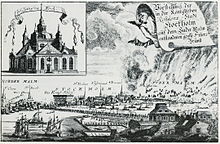| Years in Sweden: | 1720 1721 1722 1723 1724 1725 1726 |
| Centuries: | 17th century · 18th century · 19th century |
| Decades: | 1690s 1700s 1710s 1720s 1730s 1740s 1750s |
| Years: | 1720 1721 1722 1723 1724 1725 1726 |

Events from the year 1723 in Sweden.
Incumbents
[edit]Events
[edit]- January – The Estates of the Realm is assembled. The party in favor of naming Charles Frederick, Duke of Holstein-Gottorp as heir to the throne is strengthened, supported by the Empire of Russia.
- The Estates of the Realm passes a new Order on Parliamentary Proceedings, which will be a cornerstone of the Age of Liberty in Sweden. It is one of the fundamental laws of Sweden together with the Instrument of Government of 1719/1720.
- January – Frederick I tries, but fail, to strengthen the royal power against the parliament with the support of Hovpartiet, the Holstein Party fills the royal council with its followers, and Arvid Horn become a leading force within Swedish politics.
- 1 May - A great fire in Stockholm destroys the Katarina Church and a large part of the city around it.
- 17 October - A law is passed, in which the Riksdag of the Estates is granted power over the monarch and the royal council.
- - The farmers of the state are allowed to buy the land they use.
- - The Lutheran church begin to persecute Pietism, which is becoming popular in Sweden and spreading by the home coming Carolean soldiers from the Great Northern War.
- - A new educational law is passed were all parents are obliged ensure that their children knows how to read and write.
- - A French opera company, the Académie royale de musique (Stockholm), are employed to perform at Bollhuset.[1]
Births
[edit]- 5 April - Catherine Charlotte De la Gardie, countess and heroine, famed as a pioneer of vaccination and for preventing a witch trial (died 1763)
- 9 May - Pehr Osbeck, explorer, naturalist (died 1805)
- 11 October - Hedvig Strömfelt, psalm writer and a leading member of Moravian Church (died 1766)
- - Maria Carowsky, painter (died 1793)
- - Eva Merthen, war heroine (died 1811)
- Catharina Justander, Finnish (Swedish) pietist missionary (died 1778)
Deaths
[edit]- - Beata Elisabet von Königsmarck, countess and landowner (born 1637)
References
[edit]- ^ Tryggve Byström: Svenska Komedien 1737-1754 (The Swedish comedy 1737-1754) (Swedish)
Well, that’s interesting to know that Psilotum nudum are known as whisk ferns. Psilotum nudum is the commoner species of the two. While the P. flaccidum is a rare species and is found in the tropical islands. Both the species are usually epiphytic in habit and grow upon tree ferns. These species may also be terrestrial and grow in humus or in the crevices of the rocks.
View the detailed Guide of Psilotum nudum: Detailed Study Of Psilotum Nudum (Whisk Fern), Classification, Anatomy, Reproduction